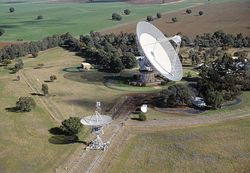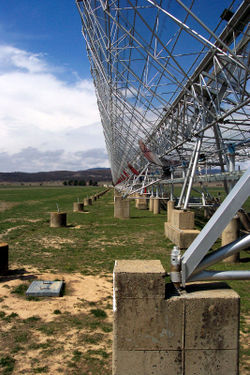Radio telescope
2007 Schools Wikipedia Selection. Related subjects: Engineering; Space (Astronomy)
A radio telescope is a form of radio receiver used in astronomy. In contrast to an "ordinary" telescope, which receives visible light, a radio telescope "sees" radio waves emitted by radio sources, typically by means of a large parabolic ("dish") antenna, or arrays of them. The first of these was the 9m telescope constructed by Grote Reber in 1937. In the early 1950s the Cambridge Interferometer mapped the radio sky to produce the famous 2C and 3C surveys of radio sources. In the late 1950s and early 1960s the largest single-dish radio telescope in the world was the 76 metre telescope at Jodrell Bank, which became operational in 1957. This was just the latest of many radio telescopes constructed during the middle of the 20th century, and has been surpassed by more modern telescopes and arrays of telescopes.
The largest individual radio telescope is the RATAN-600 (Russia) with 576 meter diameter of circular antenna ( RATAN-600 description). Other two individual radio telescopes at Pushchino Radio Astronomy Observatory, Russia, designed specially for the low frequency observations, are between the largest in their class. LPA ( LPA description (in Russian)) is 187 x 384 m size phased array meridional radio telescope, and DKR-1000 is 1000 x 1000 m cross radio telescope ( DKR-1000 description (in Russian) ). The largest radio telescope in Europe is the 100 meter diameter antenna in Effelsberg, Germany, which also was the largest fully steerable telecope for 30 years until the Green Bank Telescope was opened in 2000. The largest radio telescope in the United States until 1998 was Ohio State University's The Big Ear. Other well known disk radio telescopes include the Arecibo radio telescope located in Arecibo, Puerto Rico, which is steerable within about 20° of the zenith, and the fully steerable Lovell telescope at Jodrell Bank in the United Kingdom . A typical size of the single antenna of a radio telescope is 25 metre, dozens of radio telescopes with comparable sizes are operated in radio observatories all over the world.
An example of the array-type radio telescope is the Very Large Array (VLA), in Socorro, New Mexico, which is an interferometric array formed from 27 individual antennas. The largest exisiting radio telescope array is the Giant Metrewave Radio Telescope, located in Pune, India. A larger array, LOFAR (the 'LOw Frequency ARray') is currently being constructed in western Europe, consisting of 25 000 small antennas over an area several hundreds of kilometres in diameter.
The sub-field of astronomy related to observations made through radio telescopes is known as radio astronomy.
Many celestial objects, such as pulsars or active galaxies (like quasars), produce radio-frequency radiation and so are best "visible" or even only visible in the radio region of electromagnetic spectrum. By examining the frequency, power and timing of radio emissions from these objects, astronomers can improve our understanding of the Universe.
Radio telescopes are also the primary means to track space probes (see Deep Space Network), and are used in the SETI project.
Beginnings
Nikola Tesla in the Colorado Springs lab recorded cosmic waves emitting from interstellar clouds and red giant stars. He observed repeating signals conducted by his transceiver. He announced that he received extraterrestrial radio signals. Tesla stated that he received signals from planets in some of the scientific journals of the time. The scientific community did not believe him, primarily because research of cosmic signals did not exist (what is known today as radio astronomy), and the community of science rejected Tesla's data. Tesla spent the latter part of his life trying to signal Mars.
One of the earliest modern investigations into extraterrestrial sources of radio waves were by Karl Guthe Jansky, an engineer with Bell Telephone Laboratories, in the early 1930s. The first object actually detected was the centre of the Milky Way, followed by the sun. Grote Reber (December 22, 1911 – December 20, 2002) was one of the pioneers of radio astronomy. He was instrumental in repeating Karl Guthe Jansky's pioneering but somewhat simple work, and conducted the first sky survey in the radio frequencies. After World War II, substantial improvements in radio astronomy technology were made by astronomers in Europe, Australia and the United States, and the field of radio astronomy began to blossom.
One of the most notable developments came in 1946 with the introduction of radio interferometry (see, for example, Nature 158 pp 339 1946) by Martin Ryle's group in Cambridge (who obtained a nobel prize for this and later aperture synthesis work), also the Lloyd's mirror interferometer developed independently in 1946 by Joseph Pawsey's group at the University of Sydney (see Nature 157 pp 158 1946).
See also: History of astronomical interferometry

